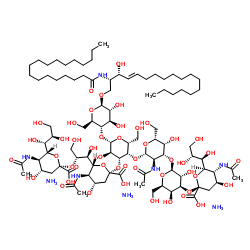Model for studying Clostridium botulinum neurotoxin using differentiated motor neuron-like NG108-15 cells.
Regina C M Whitemarsh, Christina L Pier, William H Tepp, Sabine Pellett, Eric A Johnson
Index: Biochem. Biophys. Res. Commun. 427(2) , 426-30, (2012)
Full Text: HTML
Abstract
Cancerous cell lines have traditionally shown low sensitivity to laboratory or pharmaceutical preparations of botulinum neurotoxin. The work presented here demonstrates that the mouse neuroblastoma/rat glioma hybrid cell line NG108-15 is capable of more sensitively detecting BoNT/A1 than any cell line previously described. This cell line has previously been described to have motor neuron like characteristics, therefore making it a good model to study BoNTs. Differentiation of NG108-15 cells in serum-free medium containing retinoic acid and purmorphamine dramatically increased sensitivity of the neurons to BoNT/A (EC(50) = ~16 LD(50) U). Additional pre-treatment with triasialoganglioside GT1B prior to toxin exposure reduced the EC(50) further to ~11 LD(50) U. Co-culture of the neurons with C2C12 myotubes also significantly increased BoNT/A sensitivity of NG108-15 cells (EC(50) = 26 U) in the absence of differentiation factors.Copyright © 2012 Elsevier Inc. All rights reserved.
Related Compounds
| Structure | Name/CAS No. | Molecular Formula | Articles |
|---|---|---|---|
 |
Ganglioside GT1b Mixture (bovine) (ammonium salt)
CAS:59247-13-1 |
C95H174N8O47 |
|
Botulinum neurotoxin G binds synaptotagmin-II in a mode simi...
2013-06-04 [Biochemistry 52(22) , 3930-8, (2013)] |
|
Distribution of mono-, di- and trisialo gangliosides in the ...
2012-09-01 [Biochim. Biophys. Acta 1820(9) , 1437-43, (2012)] |
|
Gangliosides prevent glutamate and kainate neurotoxicity in ...
1988-10-01 [Proc. Natl. Acad. Sci. U. S. A. 85 , 7351-7355, (1988)] |
|
GM1 / GD1b / GA1 synthase expression results in the reduced ...
2010-09-01 [Cancer Sci. 101(9) , 2039-47, (2010)] |
|
Botulinum neurotoxins B and E translocate at different rates...
2012-07-17 [Biochemistry 51(28) , 5655-62, (2012)] |